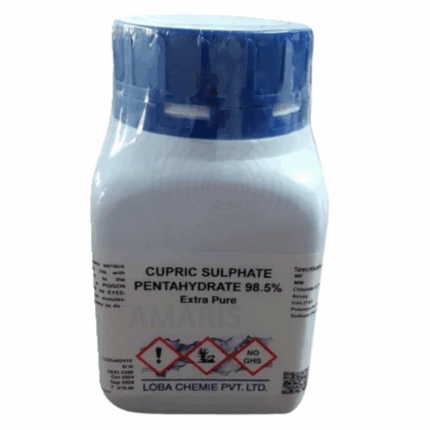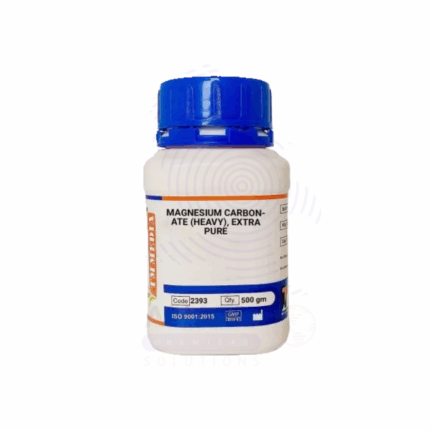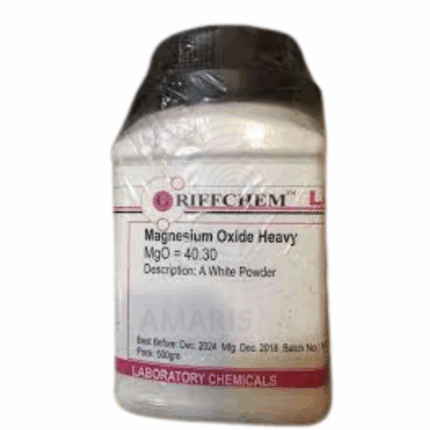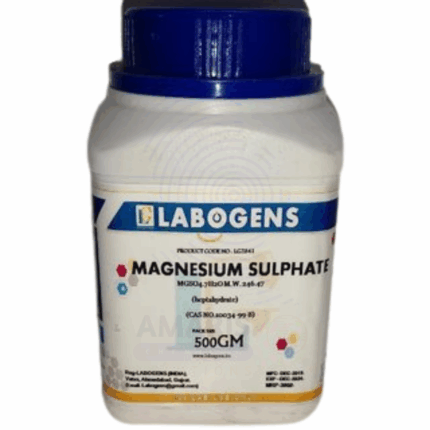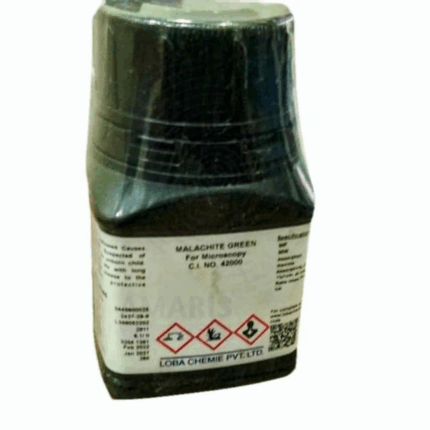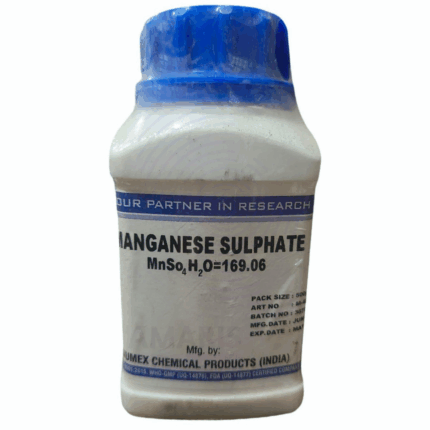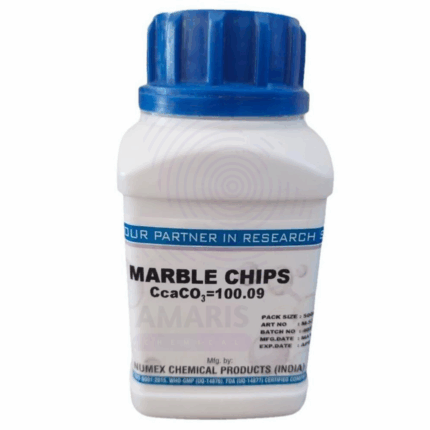
Magnesium Carbonate Extra Pure
$ 19.00 Original price was: $ 19.00.$ 18.89Current price is: $ 18.89.
Magnesium Carbonate Extra Pure is a high-purity, white powder valued for its excellent absorbent and antacid qualities. It is commonly used in pharmaceuticals as a magnesium supplement or antacid, and in food applications as a drying agent, anti-caking agent, or acidity regulator. In the cosmetics and personal care industry, it functions as a filler and a bulking agent in powders and creams. It is also employed in laboratory settings for analytical applications due to its consistent chemical composition. Its high absorbency and stability make it useful in rubber, ceramics, and sports grip products as well.
Magnesium Carbonate Extra Pure
Primary Uses
- Acid Neutralization Experiments:
- Commonly used in labs to demonstrate reactions of carbonates with acids, producing carbon dioxide.
- Source of Magnesium Ions:
- Serves as a magnesium source for preparing other magnesium-based reagents or salts.
- Drying Agent:
- Used in laboratories as a moisture absorbent or desiccant, especially in gas-drying or desiccator applications.
Secondary Uses
- Thermal Decomposition Studies:
- Useful in heat decomposition experiments to study the release of CO₂ and formation of magnesium oxide.
- Buffering and pH Adjustment:
- Occasionally used as a weak base to adjust pH in experimental setups or solutions.
- Demonstrations and Teaching:
- Ideal for educational demonstrations involving carbonate reactions, solubility, and mineral identification.
| PACK SIZE |
500 grams Plastic Tin |
|---|
1. Basic Identification Attributes
- Chemical Name: Magnesium Carbonate
- Synonyms: Magnesite, Neutral Magnesium Carbonate, Carbonic acid magnesium salt
- CAS Number: 546-93-0
- Molecular Formula: MgCO₃
- Molecular Weight: 84.31 g/mol
- Appearance: White, fine or granular powder
- Odor: Odorless
- Solubility: Practically insoluble in water; soluble in dilute acids with effervescence
- Grade: Extra Pure (high purity, suitable for laboratory use)
-
Safety & Hazard Attributes
- GHS Classification:
- Not classified as hazardous under GHS
- Hazard Statements:
- No known significant effects or critical hazards under normal conditions
- Precautionary Statements:
- P261: Avoid breathing dust
- P280: Wear eye protection, gloves, and suitable protective clothing
- P305+P351+P338: IF IN EYES, rinse cautiously with water for several minutes
- Personal Protective Equipment (PPE):
- Protective gloves
- Safety goggles
- Dust mask or particulate respirator (if airborne dust is generated)
- Lab coat
- First Aid Measures:
- Inhalation: Remove to fresh air; seek medical help if irritation persists
- Skin Contact: Wash with water and soap
- Eye Contact: Rinse with water thoroughly
- Ingestion: Rinse mouth; not expected to be harmful, but consult a physician
- Fire Hazards:
- Non-flammable
- Use fire extinguishing measures appropriate to surrounding materials
3. Storage & Handling Attributes
- Storage Conditions:
- Store in a dry, cool, well-ventilated place
- Keep the container tightly sealed
- Protect from moisture and acids
- Handling Tips:
- Avoid generating or breathing dust
- Use in well-ventilated lab areas
- Wash thoroughly after handling
4. Laboratory Applications
- Primary Uses:
- Analytical reagent in qualitative and quantitative chemical analysis
- Standard base in acid-base reactions and calibration
- Laboratory drying agent for gases and solvents
- Secondary Uses:
- Thermal decomposition studies (yields CO₂ and MgO)
- Educational demonstrations involving chemical reactions of carbonates
- Buffering agent in experimental formulations
SAFETY PRECAUTIONS
Personal Protective Equipment (PPE):
- Wear a lab coat, nitrile gloves, and protective goggles.
- Use a dust mask or operate in a fume hood to minimize inhalation of airborne particles.
Handling:
- Avoid dust formation and inhalation.
- Prevent contact with skin, eyes, and clothing.
- Wash thoroughly after handling.
- Use with adequate ventilation.
Storage:
- Store in a cool, dry, and well-ventilated area.
- Keep the container tightly closed.
- Avoid exposure to moisture and strong acids, which may cause decomposition.
FIRST AID MEASURES
Inhalation:
- Move the person to fresh air immediately.
- Get medical help if symptoms such as coughing or breathing difficulty occur.
Skin Contact:
- Wash with soap and water.
- Remove contaminated clothing.
- Seek medical advice if irritation occurs.
Eye Contact:
- Rinse cautiously with clean water for several minutes.
- Remove contact lenses if easy to do.
- Continue rinsing and get medical attention if discomfort persists.
Ingestion:
- Rinse your mouth thoroughly with water.
- Do not induce vomiting.
- Seek medical attention if symptoms or discomfort occur.
FIRE FIGHTING MEASURES
Flammability:
- Not flammable under normal use.
- Fine dust can pose a combustible dust hazard in air.
Extinguishing Media:
- Use dry chemicals, foam, CO₂, or water spray.
- Avoid full water jets that may spread dust.
Hazardous Combustion Products:
- Can produce magnesium oxides under fire conditions.
Firefighter Protection:
- Wear self-contained breathing apparatus (SCBA) and protective clothing.


 Preservatives(food)
Preservatives(food) Flavor Enhancers
Flavor Enhancers Acidulants
Acidulants Sweeteners
Sweeteners Antioxidants
Antioxidants Colorants(food)
Colorants(food) Nutraceutical Ingredients (food)
Nutraceutical Ingredients (food) Nutrient Supplements
Nutrient Supplements Emulsifiers
Emulsifiers
 Collectors
Collectors Dust Suppressants
Dust Suppressants Explosives and Blasting Agents
Explosives and Blasting Agents Flocculants and Coagulants
Flocculants and Coagulants Frothers
Frothers Leaching Agents
Leaching Agents pH Modifiers
pH Modifiers Precious Metal Extraction Agents
Precious Metal Extraction Agents
 Antioxidants(plastic)
Antioxidants(plastic) Colorants (Pigments, Dyes)
Colorants (Pigments, Dyes) Fillers and Reinforcements
Fillers and Reinforcements Flame Retardants
Flame Retardants Monomers
Monomers Plasticizers
Plasticizers Polymerization Initiators
Polymerization Initiators Stabilizers (UV, Heat)
Stabilizers (UV, Heat)
 Antifoaming Agents
Antifoaming Agents Chelating Agents
Chelating Agents Coagulants and Flocculants
Coagulants and Flocculants Corrosion Inhibitors
Corrosion Inhibitors Disinfectants and Biocides
Disinfectants and Biocides Oxidizing Agents
Oxidizing Agents pH Adjusters
pH Adjusters Scale Inhibitors( water)
Scale Inhibitors( water)
 Antioxidants(cosmetic)
Antioxidants(cosmetic) Emollients
Emollients Fragrances and Essential Oils
Fragrances and Essential Oils Humectants
Humectants Preservatives
Preservatives Surfactants(cosmetic)
Surfactants(cosmetic) Thickeners
Thickeners UV Filters
UV Filters
 Fertilizers
Fertilizers Soil Conditioners
Soil Conditioners Plant Growth Regulators
Plant Growth Regulators Animal Feed Additives
Animal Feed Additives Biostimulants
Biostimulants Pesticides (Herbicides, Insecticides, Fungicides)
Pesticides (Herbicides, Insecticides, Fungicides)
 Active Pharmaceutical Ingredients (APIs)
Active Pharmaceutical Ingredients (APIs) Excipients
Excipients Solvents(pharmaceutical)
Solvents(pharmaceutical) Antibiotics
Antibiotics Antiseptics and Disinfectants
Antiseptics and Disinfectants Vaccine Adjuvants
Vaccine Adjuvants Nutraceutical Ingredients (pharmaceutical)
Nutraceutical Ingredients (pharmaceutical) Analgesics & Antipyretics
Analgesics & Antipyretics
 Analytical Reagents
Analytical Reagents Solvents(lab)
Solvents(lab) Chromatography Chemicals
Chromatography Chemicals Spectroscopy Reagents
Spectroscopy Reagents microbiology-and-cell-culture-reagents
microbiology-and-cell-culture-reagents Molecular Biology Reagents
Molecular Biology Reagents Biochemical Reagents
Biochemical Reagents Inorganic and Organic Standards
Inorganic and Organic Standards Laboratory Safety Chemicals
Laboratory Safety Chemicals Specialty Laboratory Chemicals(Special Laboratory Equipment)
Specialty Laboratory Chemicals(Special Laboratory Equipment)
 Demulsifiers
Demulsifiers Hydraulic Fracturing Fluids
Hydraulic Fracturing Fluids Scale Inhibitors(oil)
Scale Inhibitors(oil) Surfactants(oil)
Surfactants(oil) Drilling Fluids
Drilling Fluids
 Dyes and Pigments
Dyes and Pigments Bleaching Agents
Bleaching Agents Softening Agents
Softening Agents Finishing Agents
Finishing Agents Antistatic Agents
Antistatic Agents
 Admixtures
Admixtures Waterproofing Agents
Waterproofing Agents Sealants and Adhesives
Sealants and Adhesives Curing Compounds
Curing Compounds Concrete Repair Chemicals
Concrete Repair Chemicals Anti-Corrosion Coatings
Anti-Corrosion Coatings
 Surfactants(cleaning)
Surfactants(cleaning) Builders
Builders Enzymes
Enzymes Solvents (Cleaning)
Solvents (Cleaning) Fragrances
Fragrances
 Electronic Chemicals
Electronic Chemicals Catalysts
Catalysts Lubricants
Lubricants Photographic Chemicals
Photographic Chemicals Refrigerants
Refrigerants Automotive chemicals
Automotive chemicals Pyrotechnic Chemicals
Pyrotechnic Chemicals
 Biodegradable Surfactants
Biodegradable Surfactants Bio-based Solvents
Bio-based Solvents Renewable Polymers
Renewable Polymers Carbon Capture Chemicals
Carbon Capture Chemicals Wastewater Treatment Chemicals
Wastewater Treatment Chemicals
 Pigments
Pigments Solvents(paint)
Solvents(paint) Specialty Coatings
Specialty Coatings Binders/Resins
Binders/Resins Additives
Additives Driers
Driers Anti-Corrosion Agents
Anti-Corrosion Agents Functional Coatings
Functional Coatings Application-Specific Coatings
Application-Specific Coatings
 Fresh Herbs
Fresh Herbs Ground Spices
Ground Spices Whole Spices
Whole Spices Spice Blends
Spice Blends Dried Herbs
Dried Herbs
 Leavening Agents
Leavening Agents Dough Conditioners
Dough Conditioners Flour Treatments
Flour Treatments Fat Replacers
Fat Replacers Decoratives
Decoratives Preservatives(baking)
Preservatives(baking)
 Plasticizers & Softeners
Plasticizers & Softeners Reinforcing Agents
Reinforcing Agents Adhesion Promoters
Adhesion Promoters Vulcanizing Agents
Vulcanizing Agents Antidegradants
Antidegradants Blowing Agents
Blowing Agents Fillers & Extenders
Fillers & Extenders Accelerators & Retarders
Accelerators & Retarders

